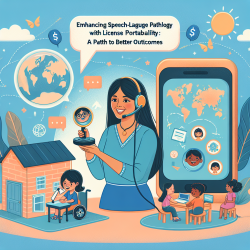Over the past decade, a chronic shortage of speech-language pathologists (SLPs) has left K-12 schools and healthcare settings in many parts of the United States struggling to provide speech therapy services. This shortage has driven up costs as institutions spend increasing time and funds searching for qualified SLPs. However, telepractice offers a promising solution by enabling practitioners to conduct live therapy sessions with clients “anytime, anywhere” using real-time videoconferencing. Research indicates that speech therapy delivered through telepractice has comparable quality and outcomes to in-person services (American Speech-Language-Hearing Association, 2005; Boisvert, Lang, Andrianopoulos, & Boscardin, 2010; Boswell, 2007; Grogan-Johnson, Alvares, Rowan & Creaghead, 2010; Grogan-Johson et al., 2011). Despite the technological advancements that have removed geographic constraints, one major barrier remains: the time-consuming and expensive licensing practices due to a lack of state license portability. While the professional requirements for licensing SLPs are very similar from state to state, each state has its own licensing process. As a result, SLPs who want to practice in multiple states must complete applications in each state, submit required documentation, pay licensing fees, and endure processing times that vary significantly by state. This duplicative process might be warranted if important state-to-state variations in professional requirements existed; however, there is a high degree of consistency in licensing requirements across states. Here are some of the key challenges related to current licensing practices:
- Processing times for applications range from weeks to months.
- Licensing application fees are typically $150 and higher for the initial application, with similar charges for annual license renewal.
- Some states require fingerprints, and states do not share fingerprint information.
The importance of licensure portability was recognized fifteen years ago when the United States Congress passed the Telecommunications Act of 1996, urging the healthcare industry to develop multi-state licensure models. Similarly, the US Federal Communications Commission called on state licensing boards to accommodate multi-state licensure for healthcare practitioners. In 2000, the National Council of State Boards of Nursing (NCSBN) instituted the Nurse License Compact (NLC), allowing nurses licensed in a compact state to practice in other compact states through a mutual license recognition model. Physicians have labor mobility through an expedited license model. True license portability for SLPs is long overdue. License portability would facilitate inter-state practice, enabling SLPs who live near state lines to practice in adjacent states where personnel shortages may exist. Greater labor mobility is necessary to serve geographically shifting populations in the US. It is time to remove the barriers to licensure portability! A national initiative that creates a model for licensure portability for the rehabilitation professions is needed. Licensure portability will enable SLPs to provide services wherever and whenever needed, thereby unleashing the full potential of telepractice to:
- Reduce costs and administrative burdens
- Increase access to services
- Broaden career opportunities for SLPs
- Improve outcomes for K-12 students and clients in diverse practice settings
A mobile, flexible workforce positioned to use telepractice for inter-state practice could alleviate the chronic shortage of SLPs. By advocating for and implementing license portability, we can ensure that high-quality speech therapy services are available to all who need them, regardless of geographic location. To read the original research paper, please follow this link:
The Time Has Come for Speech-Language Pathology License Portability! 









